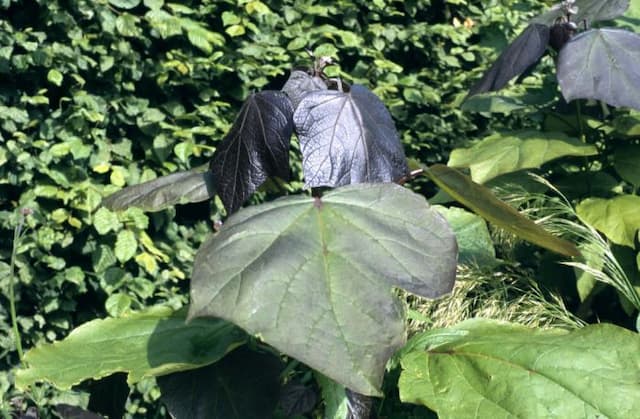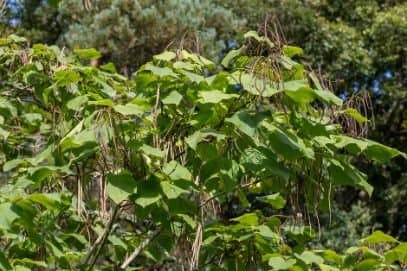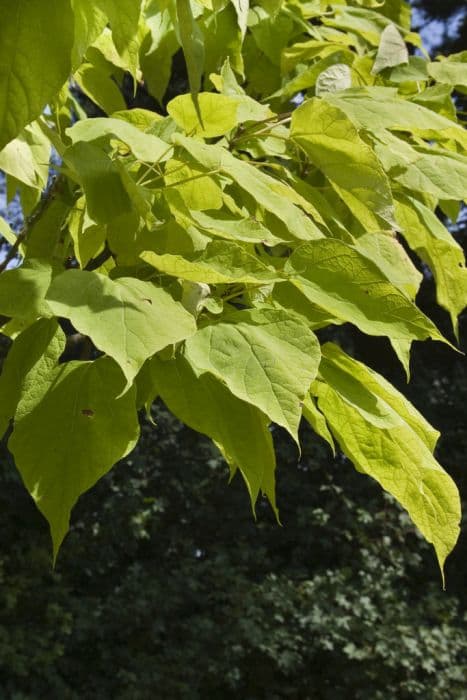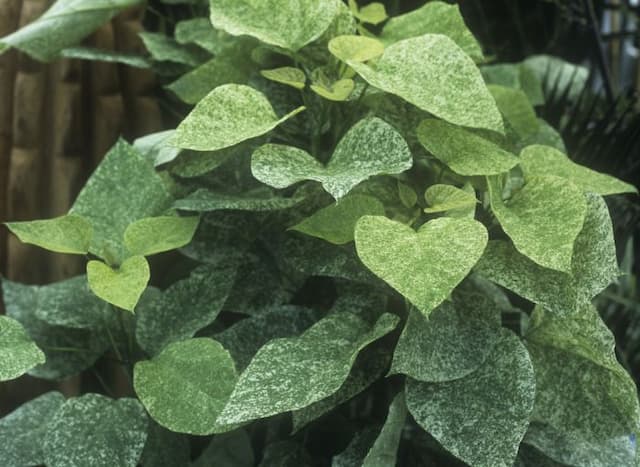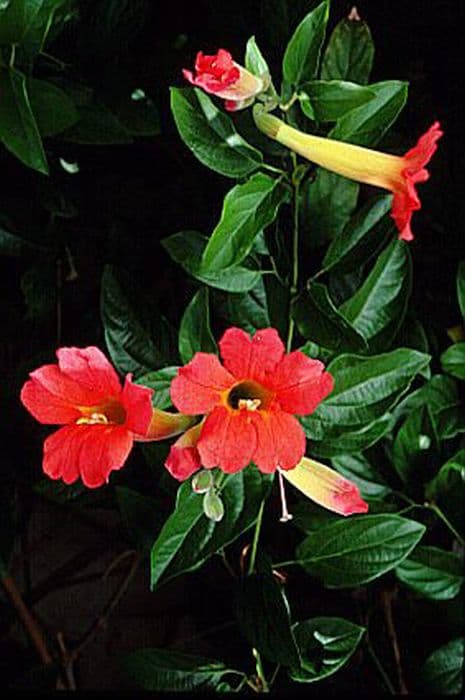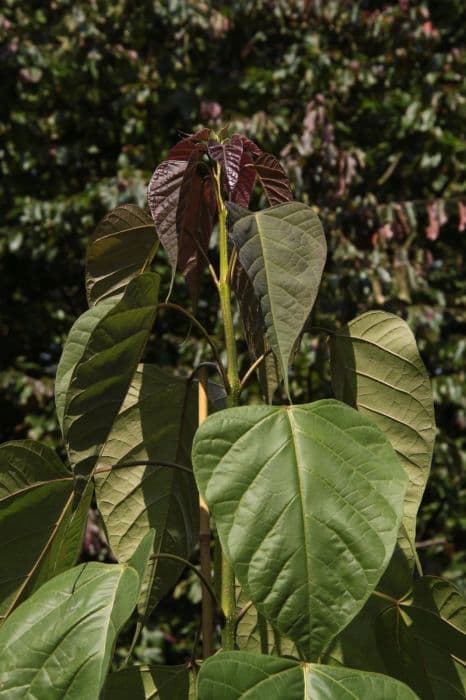Golden Catalpa Catalpa bignonioides 'Aurea'

ABOUT
The 'Aurea' variety of Catalpa, commonly known as the Golden Catalpa, is a striking ornamental tree renowned for its unique foliage and showy flowers. The heart-shaped leaves are the defining feature of this plant, having a vibrant golden-yellow color, especially vivid when the leaves are young. As they mature, the leaves take on a more muted greenish-gold hue, but still provide a bright splash of color in the landscape. During the blooming season, the Golden Catalpa produces panicles of bell-shaped flowers. These blooms are a soft white and are often adorned with yellow and purple markings, creating a delicate and somewhat exotic look. Following the flowering period, the tree develops long, bean-like seed pods that hang from the branches, adding further visual interest to the tree's appearance. The overall form of the Golden Catalapa is typically spreading with a rounded shape, giving it a stately presence. Its bark is relatively smooth with a light gray color that contrasts nicely with the bold colors of its leaves and flowers. The blend of its radiant foliage, attractive flowers, and the striking seed pods make the Golden Catalpa a distinctive and appealing addition to any garden or landscape setting.
About this plant
 Names
NamesFamily
Bignoniaceae
Synonyms
Golden Catalpa, Yellow Catalpa, Southern Catalpa, Gold Leaf Catalpa, Aurea Southern Catalpa
Common names
Catalpa bignonioides 'Aurea'.
 Toxicity
ToxicityTo humans
The common name for Catalpa bignonioides 'Aurea' is Southern Catalpa. It is generally considered to be non-toxic to humans. Ingestion of parts of this plant is not commonly associated with severe symptoms of poisoning. However, like many plants, it may cause mild stomach upset if ingested due to plant compounds that are not meant for human consumption. Eating large quantities of any plant material may lead to gastrointestinal discomfort, but the Southern Catalpa does not contain significant toxins that would lead to serious poisoning in humans.
To pets
The common name for Catalpa bignonioides 'Aurea' is Southern Catalpa. This plant is not typically listed as toxic to pets, such as dogs and cats. However, as with humans, the ingestion of plant material can cause mild gastrointestinal upset in some pets. Symptoms could include vomiting or diarrhea if a pet were to consume a large amount of the plant. Despite this, the Southern Catalpa is not known to cause serious or life-threatening poisoning in pets. It is always best to discourage pets from chewing on or ingesting any plant material to prevent any potential discomfort.
 Characteristics
CharacteristicsLife cycle
Perennials
Foliage type
Deciduous
Color of leaves
Golden
Flower color
White
Height
30 feet (9 meters)
Spread
30 feet (9 meters)
Plant type
Tree
Hardiness zones
5
Native area
Southeastern United States
Benefits
 General Benefits
General Benefits- Shade Provider: The Southern Catalpa, with its broad canopy, offers large areas of shade, making it ideal for parks and large gardens.
- Aesthetic Appeal: With its striking golden-yellow foliage, 'Aurea' adds a burst of color and can serve as an ornamental centerpiece in landscape design.
- Attracts Wildlife: The tree's flowers are attractive to bees, while its seeds are food for various bird species, thereby supporting local ecosystems.
- Durable Wood: Southern Catalpa wood is resistant to rot and decay, making it useful for outdoor applications like fence posts and furniture.
- Low Maintenance: Once established, it is relatively easy to care for, requiring minimal attention other than occasional pruning.
- Urban Tolerant: The species can tolerate urban conditions such as air pollution and compacted soil, making it suitable for city environments.
- Seasonal Interest: Its large, trumpet-shaped flowers bloom in late spring to early summer, followed by long, bean-like pods, both adding seasonal interest.
- Historical Significance: Southern Catalpa trees have been planted and appreciated in certain regions for centuries, providing a sense of historical continuity in landscapes.
 Medical Properties
Medical PropertiesThis plant is not used for medical purposes.
 Air-purifying Qualities
Air-purifying QualitiesThis plant is not specifically known for air purifying qualities.
 Other Uses
Other Uses- The large heart-shaped leaves of the Catalpa can be used in art projects such as leaf painting or printing due to their distinct shape and prominent veins.
- Catalpa wood, being resistant to rot, can be used in garden projects such as building raised beds or constructing trellises for climbing plants.
- Its large, bean-like seed pods can be used in dried flower arrangements or as part of craft decorations once they have matured and dried out.
- The tree can be grown as a bonsai, offering enthusiasts a chance to work with its unique features on a miniature scale.
- The dense foliage can provide a private screen or natural barrier when planted in rows, making it ideal for creating seclusion in a garden space.
- When the tree is in bloom, the flowers can be harvested and used as a natural yellow dye for fabrics and yarns.
- The early summer blossoms are a nectar source for bees, thus Catalpa can be strategically planted to support local bee populations and pollinator-friendly gardens.
- In woodworking, the lightweight and pale wood of the Catalpa is sometimes used for specialty items like wooden utensils or decorative boxes.
- The Catalpa's broad canopy provides a cool, shaded area in landscapes, which is ideal for a relaxation spot or children's play area during hot summer months.
- Some musicians appreciate the resonant quality of Catalpa wood and may use it to craft certain musical instruments such as drums or specialty guitars.
Interesting Facts
 Feng Shui
Feng ShuiThe Southern Catalpa is not used in Feng Shui practice.
 Zodiac Sign Compitability
Zodiac Sign CompitabilityThe Southern Catalpa is not used in astrology practice.
 Plant Symbolism
Plant Symbolism- Resilience: The Catalpa tree, known for its hardiness and ability to thrive in various conditions, symbolizes resilience and the ability to withstand challenges.
- Longevity: With its potential for a long life, the Catalpa represents longevity and endurance over time.
- Protection: The broad leaves of this tree provide ample shade, symbolizing protection and shelter.
- Beauty: The striking appearance of the 'Aurea' variety, with its golden leaves, stands for natural beauty and uniqueness.
- Freedom: The way the tree allows its seeds to freely disperse with the wind can be seen as a symbol of freedom and independence.
 Water
WaterThe Golden Catalpa requires deep watering when the top few inches of soil are dry, which usually means once a week during hot, dry periods and less frequently during cooler months. It's better to water this plant deeply and infrequently rather than little and often, which encourages deep root growth. A general recommendation is to provide about 1.5 to 2 gallons of water per watering session, adjusting as needed based on weather conditions and soil drainage. Ensure the water penetrates the root zone, reaching the entire area under the tree's canopy. Over-watering or allowing the tree to sit in water can cause root rot, so it's important to let the soil dry slightly between watering sessions.
 Light
LightThe Golden Catalpa thrives best in full sunlight to partial shade. It should be planted in a location where it can receive at least six hours of direct sunlight each day to promote healthy growth and flowering. While it can tolerate some shade, too much shade can lead to reduced foliage density and fewer blooms.
 Temperature
TemperatureThe Golden Catalpa is well-suited to a range of temperatures and can survive minimum winter temperatures down to about -20°F but prefers the warmer summer temperatures between 60°F and 90°F. The ideal growing conditions for this tree are in USDA hardiness zones 5 through 9, where it is most likely to thrive.
 Pruning
PruningThe Golden Catalpa benefits from pruning to maintain its shape and remove any damaged or diseased branches. The best time to prune is during the dormant season, in late winter or early spring before new growth begins. Pruning once a year is usually enough to keep the tree healthy and looking its best. When pruning, make sure to make clean cuts and avoid tearing the bark to facilitate quick healing.
 Cleaning
CleaningAs needed
 Soil
SoilThe Southern Catalpa, commonly known as Catalpa bignonioides 'Aurea', thrives best in a soil mix that is rich in organic matter, well-draining, and has a slight acidity to neutral pH range of 5.5 to 7.0. A recipe for the ideal soil mix could include equal parts of loamy garden soil, peat or compost, and sharp sand or perlite for improved drainage.
 Repotting
RepottingThe Southern Catalpa does not need frequent repotting; young trees may benefit from being repotted every couple of years to encourage growth but mature trees are usually repotted much less frequently, only when the root system has outgrown the current container.
 Humidity & Misting
Humidity & MistingThe Southern Catalpa is not particularly demanding regarding humidity levels, but it thrives in average outdoor ambient humidity. It can tolerate some variation in humidity, although extremes should be avoided.
 Suitable locations
Suitable locationsIndoor
Place in bright, indirect light; keep room temperature stable.
Outdoor
Full sun to partial shade; protect from strong winds.
Hardiness zone
5-9 USDA
 Life cycle
Life cycleThe Southern Catalpa, also known as Catalpa bignonioides 'Aurea', initiates its life cycle as a dormant seed, which after experiencing stratification to break dormancy, germinates in the presence of adequate moisture and temperatures. Following germination, a root system develops and a shoot emerges from the soil, growing into a seedling with characteristic heart-shaped, yellowish leaves due to the 'Aurea' variety. As the seedling matures, it develops into a young tree experiencing rapid growth, with long, showy pods and white, bell-shaped flowers with purple and yellow inner spots typically appearing in late spring to early summer. After reaching maturity, the Southern Catalpa enters a reproductive phase annually, involving flower pollination, often by bees, and subsequent pod formation which contains numerous winged seeds. Throughout its adult life, which can span decades, the tree undergoes annual cycles of flowering, seed production, and leaf drop in the autumn. Finally, when reaching the end of its life span, the Southern Catalpa declines and eventually dies, leaving seeds that may perpetuate the life cycle.
 Propogation
PropogationPropogation time
Late winter
The Southern Catalpa or Catalpa bignonioides 'Aurea' can be propagated by seed or more commonly by stem cuttings. The most popular method is stem cuttings which is frequently done in late spring to early summer when the tree is actively growing. Semi-hardwood cuttings, which are stems that are beginning to mature and have a firm yet flexible consistency, are taken from the current year's growth. These cuttings, around 6 to 8 inches long, are stripped of leaves on the lower half and dipped in a rooting hormone to facilitate root development. The prepared cuttings are then placed in a moist, well-draining growing medium such as sand or a mix of perlite and peat. They are kept under high humidity conditions, which can be achieved by covering them with a plastic bag or placing them in a propagation chamber. Within a few weeks to months, roots will form, after which the cuttings can be transferred to pots or the ground for further growth.


